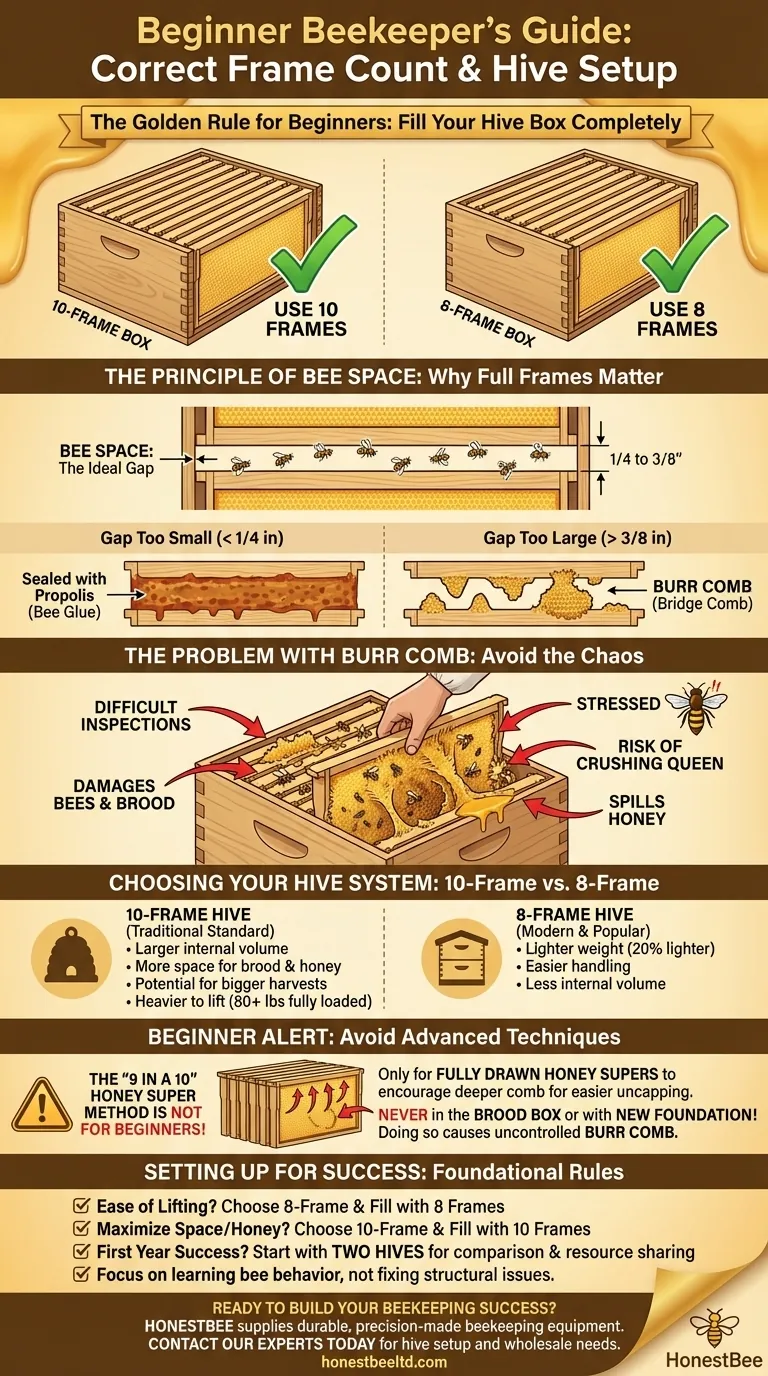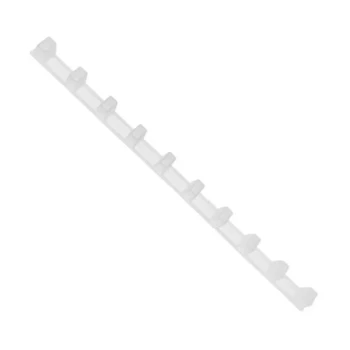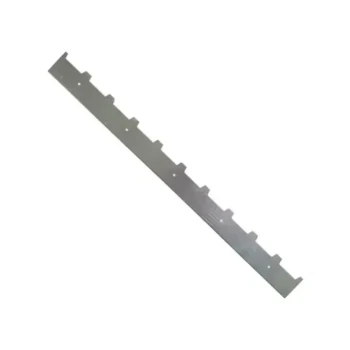For a beginner beekeeper, the rule is straightforward: you must completely fill your hive box with the number of frames it is designed to hold. This means you will use 10 frames in a 10-frame box or 8 frames in an 8-frame box. This practice is critical for every new box you add to your hive.
The number of frames is not a suggestion; it is a structural requirement for the bees. Failing to use a full set of frames invites the colony to build uncontrolled "burr comb" in the empty space, making hive inspections difficult, damaging to the bees, and potentially fatal to your queen.

The Principle of Bee Space
The rule about filling a hive box is rooted in a fundamental concept of beekeeping known as bee space. This is the precise gap (roughly 1/4 to 3/8 of an inch) that bees will naturally leave open as a walkway.
Understanding Bee Behavior
Bees are genetically programmed to manage the space within their hive. Any gap smaller than bee space will be sealed with propolis (a resinous "bee glue"), and any gap larger than bee space will be filled with beeswax comb.
When you leave a frame out of a new box, you create a large, unregulated gap. The bees will not see this as an error; they will see it as an opportunity to build comb according to their own logic, not yours.
The Problem with Burr Comb
This wild, irregularly built comb is called burr comb (or bridge comb). While natural for bees, it is a significant problem for the beekeeper.
Burr comb often connects adjacent frames or attaches frames to the walls of the hive box. When you attempt to pull a frame for inspection, you will inevitably tear this comb, crushing bees, spilling honey, and destroying brood. Worse, you risk "rolling" and killing your queen, which can doom the colony.
Choosing Your Hive: 8-Frame vs. 10-Frame Systems
The question is not how many frames to put in a box, but which box system to choose in the first place. For beginners, the Langstroth hive is the universal standard, and it comes in two common sizes.
The 10-Frame Hive
This is the traditional, classic size. Its main advantage is a larger internal volume, which provides more space for the queen to lay eggs and for workers to store honey. This can lead to larger populations and bigger honey harvests.
The 8-Frame Hive
This is a more modern, increasingly popular option. Its primary advantage is weight. A fully-loaded 10-frame deep box can weigh over 80 pounds, whereas an 8-frame box is about 20% lighter and easier to handle.
Understanding the Trade-offs: Beginner Rules vs. Advanced Techniques
You may eventually hear experienced beekeepers talk about using fewer frames than a box holds. It is critical to understand the context for this practice and why it is not for beginners.
The "9 in a 10" Honey Super Method
Some beekeepers will remove one frame from a 10-frame honey super after the bees have fully built out the comb on all 10 frames. This is called "9 in a 10" spacing.
Giving the bees slightly more space encourages them to build the honeycomb out deeper on the remaining 9 frames. This makes the honey cells easier to uncap during extraction.
Why Beginners Must Avoid This
This technique is only for honey supers where the comb is already fully drawn. It is never done in the brood box where the queen lays her eggs.
If you attempt this with new, undrawn foundation, the bees will simply build chaotic burr comb in the gaps, leading to all the problems mentioned earlier. As a beginner, your priority is establishing a healthy colony with straight, manageable comb.
Setting Up Your First Apiary for Success
Your initial setup choices are about creating a predictable, manageable environment for both you and your bees. Following standard practices allows you to focus on learning bee behavior instead of correcting structural problems.
- If your primary focus is ease of lifting: Choose an 8-frame hive system, and be sure to fill every box with all 8 frames.
- If your primary focus is maximizing space and honey potential: Choose a 10-frame hive system, and fill every box with all 10 frames.
- To increase your chances of success in the first year: Start with two hives instead of one, as this allows you to compare colony health and share resources if one hive struggles.
Following these foundational rules removes guesswork and allows you to focus on the most important job: learning to observe and care for your bees.
Summary Table:
| Hive Box Type | Recommended Frames for Beginners | Key Consideration |
|---|---|---|
| 10-Frame Box | 10 Frames | Maximizes brood/honey space; heavier to lift (80+ lbs). |
| 8-Frame Box | 8 Frames | 20% lighter for easier handling; less internal volume. |
Golden Rule: Always fill the box with the number of frames it is designed to hold.
Ready to build your beekeeping success from the ground up?
Starting with the right equipment is the first step to a healthy, productive apiary. HONESTBEE supplies durable, precision-made beekeeping supplies and equipment to commercial apiaries and beekeeping equipment distributors.
Let us help you get started on the right foot. Contact our experts today to discuss your hive setup and wholesale needs.
Visual Guide

Related Products
- Durable Plastic Frame Spacer
- Ergonomic Plastic Frame Spacer Tool for Rapid Hive Management Beekeeping
- Stainless Steel 9 Frame Hive Spacer Durable Precise for Commercial Beekeeping
- Professional Castellated Iron Frame Spacer for Multiple Hive Types
- Wooden Bee Hive Frames for Beekeeping and Wholesale
People Also Ask
- How is the spacing of frames managed in a nuc super? A Beekeeper's Guide to Perfect Comb
- Why use 9 frames in a 10 frame hive? Optimize Honey Harvesting with Strategic Spacing
- What to do if bees are building combs between frames? A Guide to Fixing Burr Comb
- How often should beehive frames be inspected and cleaned? A Guide to Hive Health & Honey Quality
- What is 'bee space' and why is it important? The Key to Modern Beekeeping Success



















